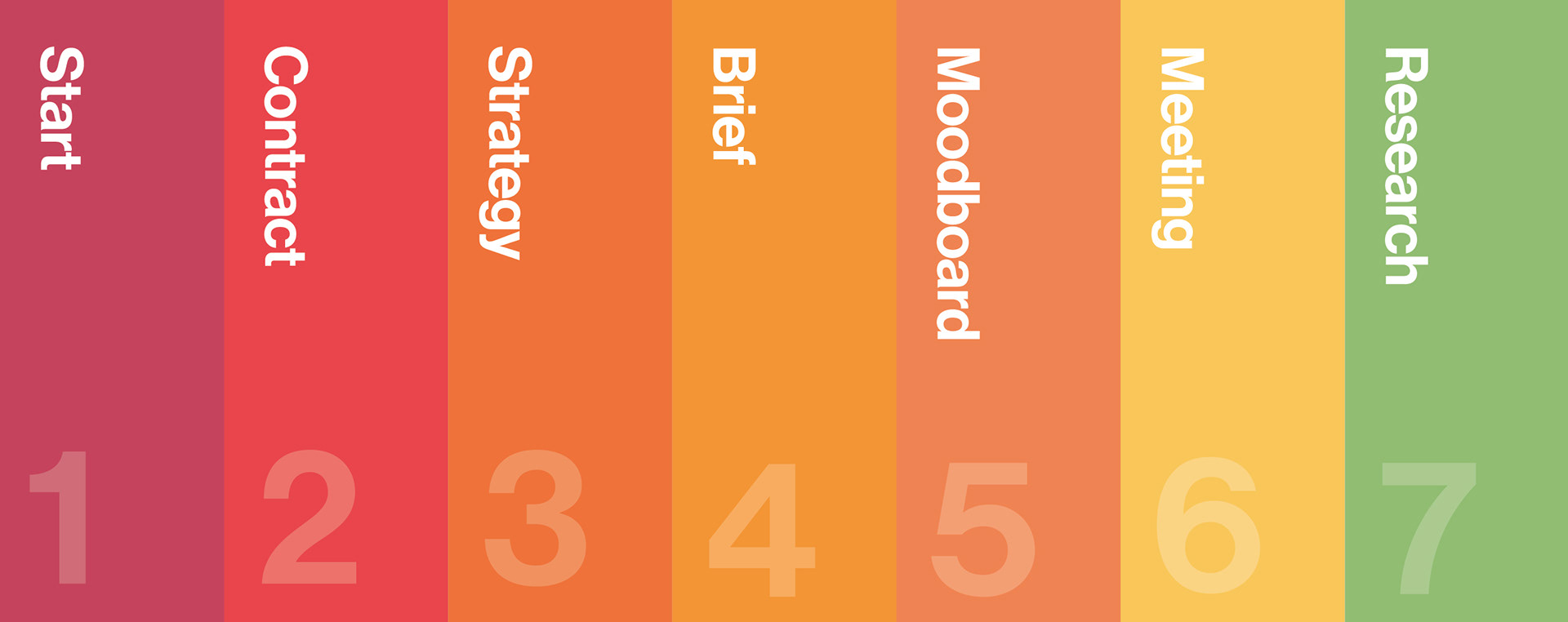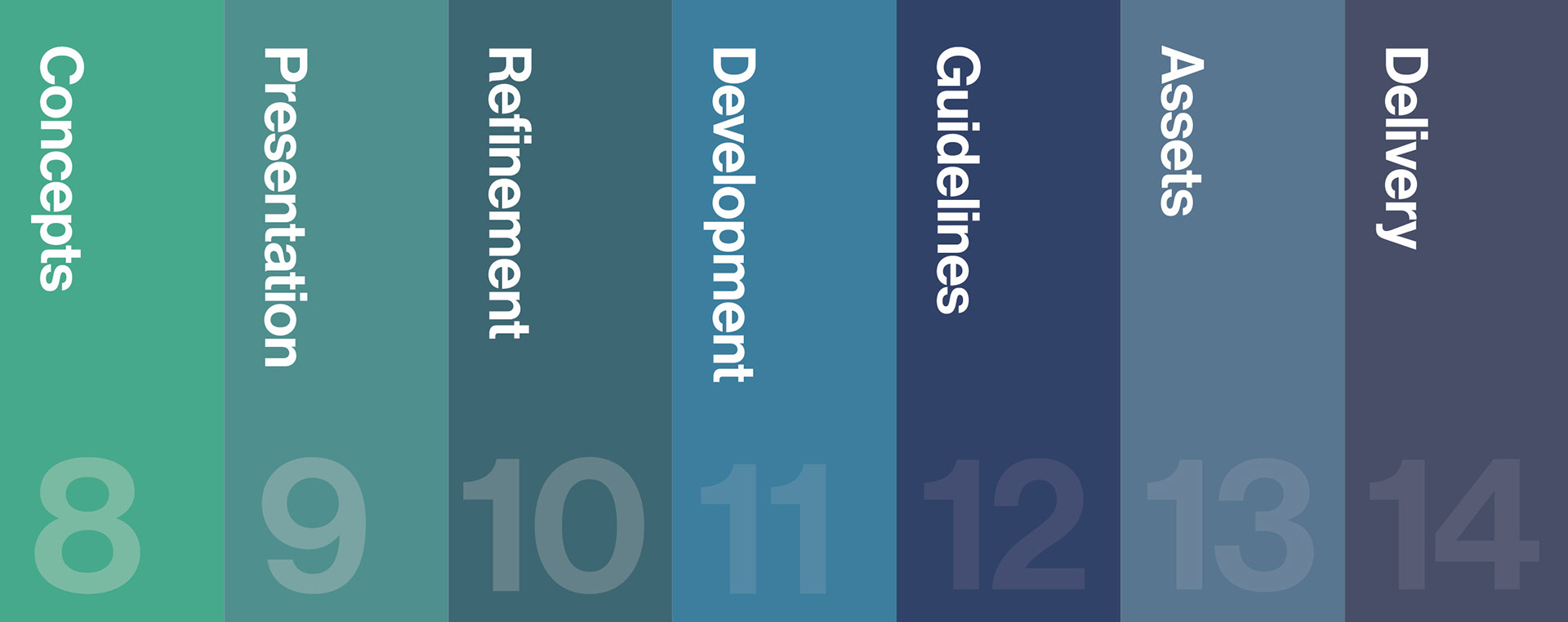

My Brand Design Process.
_____
At the start of any design project its important to have a solid Design Process in place – setting out clear and realistic expectations from the outset ensures everything runs smoothly.
This is an example of my Design Process for a new brand, most design projects will follow a similar pattern.
1
.
1
Start project
Get in touch either fill out the form on my contact page, or email me and I’ll schedule a short call to meet you and talk about your project and the problems you’re facing and we can both establish if we are a good fit.
2
Contract
After your initial enquiry I’ll send you a Statement Of Work document and Quote that will form our contract.
On approval a 50% deposit is required which will secure your spot on my calendar once signed and paid. Remaining payment is due prior to release of final artwork.
3
Brand Strategy
Before starting work on any new design It’s essential to define the Brand Strategy. I ask my clients to fill in a questionnaire breaking down your organisation to its bare essentials:
• What you stand for
• Your offer
• The promise your brand makes to your customers
• Your target audience
• Mission and vision
• Value proposition
• Personality
• Competitors
• Your offer
• The promise your brand makes to your customers
• Your target audience
• Mission and vision
• Value proposition
• Personality
• Competitors
This is written up into a document and approved by the client
4
Design Brief
Next I will create the Design Brief which contains:
• Project summary
• Main business objective
• Value proposition - key message
• Core values
• Customer benefits
• Target audience
• Competitors
• Brand personality
• Creative direction
• Brand elements
• Communication channels
• Timescales
• Main business objective
• Value proposition - key message
• Core values
• Customer benefits
• Target audience
• Competitors
• Brand personality
• Creative direction
• Brand elements
• Communication channels
• Timescales
This is written up into a document and approved by the client.
The Brand Strategy and Creative Brief acts as a reference point that guides the design direction ensuring delivery of consistent brand assets across all client touch points and also acts as a benchmark against which to gauge whether the creative concepts are relevant.
5
Client Moodboard
I ask my client to create a Moodboard on Pinterest to get an idea of how they think their brand should translate visually. Anything can be included, from logos, packaging inspiration, signage ideas, brochure spreads, photographs, patterns, illustrations etc. Anything that helps me get an picture of what they’re thinking.
6
Client Zoom Meeting
This will take place a week before commencing the project. We will talk together about the project in more detail going through the Brand Strategy, Design Brief, Moodboard and the Design Process.
7
Research
The next stage is where I research and review all the information gathered and start looking at competitor brands, styles and trends that might have an influence on the visual direction.
8
Concepts
I then put pen to paper and begin word mapping and sketching rough ideas out on paper, there is normally one standout idea that fits the Creative Brief which I develop further on the computer to finished visual stage.
9
Presentation
I present your new design via a Zoom call explaining the rational behind my decision-making process taking into consideration what will appeal to the target audience, as well as what will communicate the brand mission and personality in the most compelling and memorable way.
I show the new design working in multiple sizes and real life platforms relevant to your industry such as print, computer screens packaging, bags, signs or vehicle graphics.
After the presentation I will send you PDFs for you to review and gain feedback from your team.
10
Refinement
Any changes you wish to make are best submitted at the same time – I’ll confirm the requested edits and make the revisions and submit a new draft for review.
It usually takes no more than 3 revisions to reach the final design because we’ve laid good groundwork for the project, the proposed solutions are normally right on target.
11
Brand Development
The design concept is further developed into the wider identity, including the colour palette, typeface combinations, icons, logo variations, photography, illustrations and patterns.
12
Brand Guidelines document
Once the identity has been approved the next stage is to create the Brand Guidelines document. This is an essential document providing clear and consistent direction to anyone working with the brand on how it should be applied visually and verbally.
The document usually includes:
• Brand overview
• Brand personality and tone of voice
• Logo variations
• Colour palette
• Typography
• Icons, photography, illustration and pattern styles
• Layout grid and principles
• Brand personality and tone of voice
• Logo variations
• Colour palette
• Typography
• Icons, photography, illustration and pattern styles
• Layout grid and principles
I then send this to my client to review and approve.
13
Brand Communication assets
Any Individual brand items outlined in the Creative Brief are started:
• Business cards and letterhead
• Brochures
• Newsletters
• Annual reports
• Marketing literature
• Packaging
• Advertising
• Social media pages
• Website homepage
• Posters
• Calendars
• Advertising
• Email signature
• Business cards and letterhead
• Brochures
• Newsletters
• Annual reports
• Marketing literature
• Packaging
• Advertising
• Social media pages
• Website homepage
• Posters
• Calendars
• Advertising
• Email signature
14
Delivery of assets
After approval of designs and final payment all final artwork files are delivered to you:
• Brand guidelines
• Logo variations
• Icons
• Fonts
• Photography, illustrations and patterns
• Individual brand items
• Logo variations
• Icons
• Fonts
• Photography, illustrations and patterns
• Individual brand items
